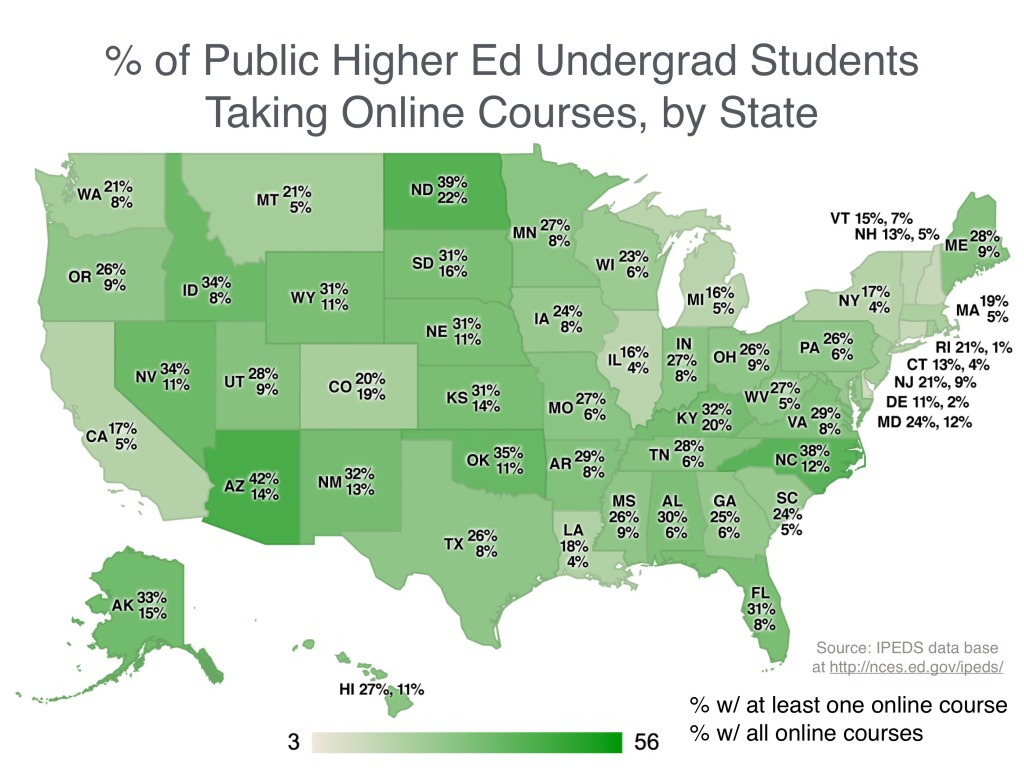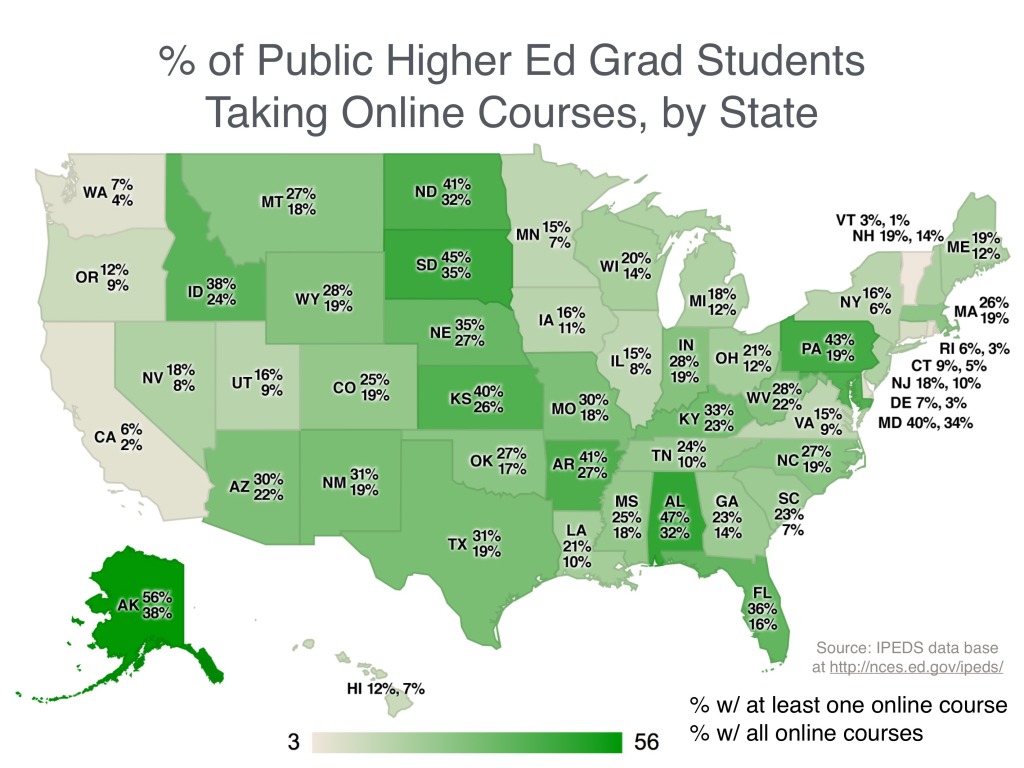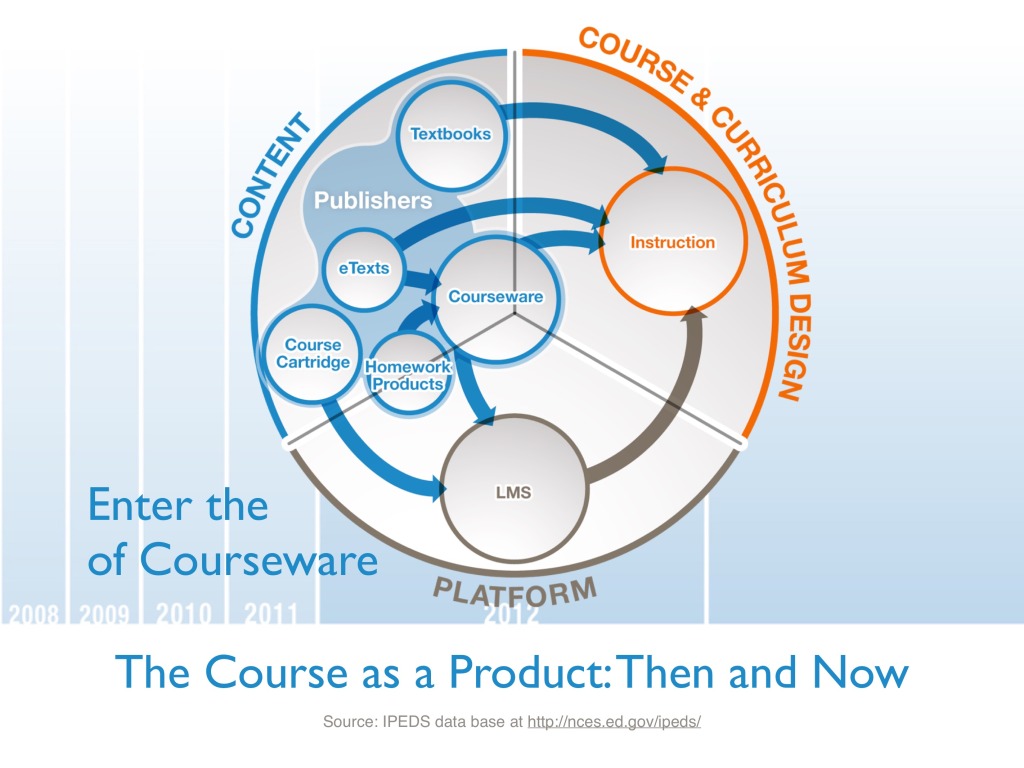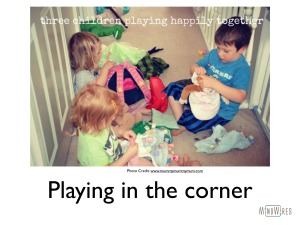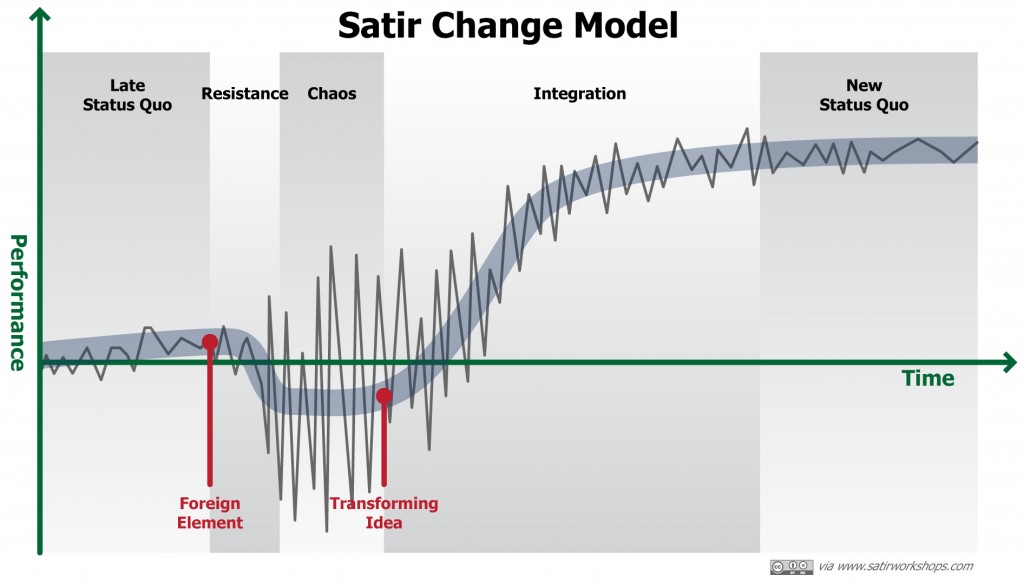Last week I spoke on a panel at the Association of Public and Land-grant Universities (APLU) annual conference. Below are the slides and abridged notes on the talk.
It is useful to look across many of the technology-drive trends affecting higher education and ask what that tells about faculty of the future. Distance education (DE) of course is not new, and the first DE course came out in the mid 1800s in a course from London on shorthand. These distance, or often correspondence, course have expanded over time, but with the rise of the Internet online education (today’s version of DE) has been accelerating over the past 20 years to become quite common in our higher education system.
For the first time IPEDS has been collecting data on DE, starting with Fall 2012 data. We finally have some real data to show us what is happening state-by-state and by different measures. We’re talking numbers from 20 – 40+% of students taking at least one online course with public 4-year institutions. This is no longer just a fringe condition for our students – it’s hitting the mainstream.
We’re now in an area where online courses are becoming a standard part of our students’ educational experience. The student demographics and experience are changing. Much of this is driven by working adults, people coming back into college to get a degree, and what used to be called non-traditional students. What we know, of course, is that non-traditional students are now in the majority – we need new terminology.
The numbers we’re discussing with distance education really understate the change. There is no longer a simple dualism of traditional vs. online education. We’re seeing an emerging landscape of educational delivery models. What does this emerging landscape of educational delivery models look like? I have categorized the models not just in terms of modality—ranging from face-to-face to fully online—but also in terms of the method of course design. These two dimensions allow a richer understanding of the new landscape of educational delivery models. Within this landscape, the following models have emerged: ad hoc online courses and programs, fully online programs, School-as-a-Service or Online Service Providers, competency-based education, blended/hybrid courses and the flipped classroom, and MOOCs.
The vertical axis of course design gets at the core assumption that underlies much of the higher education system – the one-to-one relationship between a faculty member and a course. With many of the new models, we’re getting into multi-disciplinary faculty team designs and even team-based course designs include faculty, subject matter experts, instructional designers, and multi-media experts. These models raise a lot of questions over ownership of content and ability or permission to duplicate course section.
These new models change the assumptions of who owns the course, and it leads to different processes for designing, delivering, and updating courses–processes that just don’t exist in traditional education. The implications of this approach are significant. These differences create a barrier that very few institutions can cross.
It is culturally difficult to cross the barrier into the area of team-based course design, and yet this is where many of the new technology-enabled models involve.
There is another case of seeing the Course as a Product. Previously we had three separate domains with content (typically provided by publishers), platforms (typically provided by LMS vendors) and course and curriculum design (typically provided by faculty and academic departments. What we’re seeing more recently is the breakdown, or merging, of these domains with various products and services overlapping. Digital content includes both content and platform. Courseware, however, takes this tot the next level and organizes the content and delivery around learning outcomes. In other words, Courseware actually overlaps into the domain and course and curriculum design.
From an organizational change perspective, however, we are just now starting to see how digital education is affecting the mainstream of higher education. We’re not just dealing with niche programs but also having to grapple with how these changes are affecting our institutions as a whole.
Another way of viewing this situation is that we had been used to people experimenting with digital education as a group quietly playing in the corner.
But these people are contained no more and are loose in the house, often causing chaos but also having fun.
These moves raise many questions that need to be addressed at a policy and faculty governance level.
- How broadly are we applying these initiatives? There are big questions in figuring out which pilot programs to start, whether and when to expand the new models beyond an isolated program more broadly.
- Who owns the course when a team works on the design from start to finish?
- Who needs to give permission to take a master course and duplicate into multiple shells, or course sections, taught by others?
- How should faculty be credited for team-based course design and how should professional development opportunities adjust?
The late family therapist Virginia Satir created a model that can describe much of the changes arising from technology-based innovations. The model shows how social systems or cultures react to a transformative event through various stages (see Steve Smith’s post for more information).
The issue for our discussion is that a foreign element – the change or innovation – is the key event that triggers the move away from the late status quo. This change typically leads to resistance, and eventually to a period of chaos. During these two phases, the performance of the social system fluctuates to a large degree and actually is often worse than during the status quo phase, as the social system wrestles with how to integrate the change in a manner that produces benefits. The second key event is the transforming idea, when people determine how to integrate the innovation into the core of the social system. This integration phase leads to real performance improvements as well as less fluctuation. As the innovation reaches a critical mass, a new status quo develops.
It is not a given that the innovation actually takes hold, there are cases where the social system does not benefit from the innovation.
Some of the implications for faculty during these times of change:
- With all of the changes, it’s not just that change should be difficult, but also that performance will fluctuate wildly and often our outcomes will get worse as the system adapts to an innovation.
- The foreign element that dismantles the status quo is not necessarily the basis of technology adoption that gets adopted. The transforming idea is typically related to the foreign element, but it is not equivalent. Faculty ideally will have the time and opportunity to help “find” the transforming idea.
- It would be a mistake to add accountability measures prematurely, when the system has not had a chance to figure out how to successfully improve outcomes.
Many of these digital education models also raise the question of whether the faculty members need to be on campus, and if not, what support structures should be in place to help out these distance faculty. What about professional development opportunities? Beyond that, how to do you include distance faculty in governance processes.
Other changes, such as competency-based education, can move beyond seat time as a core design element. But how does this change faculty compensation and faculty workload?
We also see faculty age assumptions. What I’m seeing lately is more and more evidence that this assumption is incorrect – older faculty in general are not more resistant to change than younger faculty – and this could have implications for ed tech initiatives struggling to get faculty buy-in.
In a recent post here at 20MM, I pointed out an interesting finding from a recent survey on the use of Open Educational Resources (OER) by the Babson Survey Research Group.
It has been hypothesized that it is the youngest faculty that are the most digitally aware, and have had the most exposure to and comfort in work with digital resources. Older faculty are sometimes assumed to be less willing to adopt the newest technology or digital resources. However, when the level of OER awareness is examined by age group, it is the oldest faculty (aged 55+) that have the greatest degree of awareness, while the youngest age group (under 35) trail behind. The youngest faculty do show the greatest proportion claiming to be“very aware” (6.7%), but have lower proportions reporting that they are “aware” or “somewhat aware.”
Combine this finding with one from another recent survey by Gallup, sponsored and reported by Inside Higher Education.
The doubt extends across age groups and most academic disciplines. Tenured faculty members may be the most critical of online courses, with an outright majority (52 percent) saying online courses produce results inferior to in-person courses, but that does not necessarily mean opposition rises steadily with age. Faculty respondents younger than 40, for example, are more critical of online courses (38 percent) than are those between the ages of 50 and 59 (34 percent).
These findings challenge the predominant assumption about older faculty being more resistant to change, but I would not consider it proof of the reverse. For now, I think the safest assumption is to stop assuming that age is a determining factor for ed tech and pedagogical changes from faculty members. What are the implications?
- I have heard informal comments at schools about instituting change by waiting it out – letting the resistant older faculty retire over time and allowing innovative younger faculty to change the culture. This approach and assumption could be a mistake.
- Everett Rogers has found that opinion leaders play a crucial role in the change process. There could be key advantages in actively reaching out to older faculty who might be established opinion leaders to include them directly in change initiatives.
- We should not assume that older faculty would not want additional support and professional development. These ‘senior’ faculty members may need additional opportunities to learn new technologies, but you might be surprised to find they are more receptive to experimentation and participation in change initiatives.
I would not presume to be able to answer these questions for you, but I think it is important to highlight how technology changes will have faculty support and management implications that go well beyond niche programs and could change the faculty of the future. These innovations are having a broader effect.
Q (audience). Another dimension is that we’re seeing more need for interaction, seeking greater impact with students. We need more meaningful interactions between faculty and students. How do these changes apply to interaction?
A. One of the most encouraging aspects in the study mentioned from Inside Higher Ed faculty survey showed that the biggest definition of quality in online learning (and hopefully f2f learning) is mentorship. The quality of an online course or program depends on the design and implementation. There are a lot of bad online courses with poor engagement. But at the same time there are many well-designed online courses with more interaction between faculty and student that is even possible in traditional face-to-face courses. For example, online tools can increase the ability to reach out to introverts and bring them in to group discussions. Well-design learning analytics can act as a teacher’s eyes and ears to see more directly how different students are doing in the class. Moving forward, this is one of the biggest opportunities to enhance interaction. You raise a good point, though – it’s a challenge and cannot just be solved automatically.
If faculty or an institution fall back on traditional course design just being placed online, there will be problems. Some of the best-designed courses, however, go beyond the official LMS tools and use social media, blogs, and various interactive tools to enhance creativity and interaction. Long and short – it’s not a matter of if a course or program is put online, it’s a matter of how the course is designed, the faculty role in actively creating opportunities for interaction, and adequate support for students and faculty.
